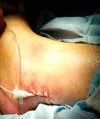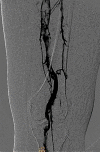Catheter-Directed Thrombolysis via Small Saphenous Veins for Treating Acute Deep Venous Thrombosis
- PMID: 27552357
- PMCID: PMC5006714
- DOI: 10.12659/msm.897016
Catheter-Directed Thrombolysis via Small Saphenous Veins for Treating Acute Deep Venous Thrombosis
Abstract
BACKGROUND There is little data comparing catheter-directed thrombolysis (CDT) via small saphenous veins vs. systematic thrombolysis on complications and efficacy in acute deep venous thrombosis patients. The aim of our study was to compare the efficacy and safety of CDT via the small saphenous veins with systematic thrombolysis for patients with acute deep venous thrombosis (DVT). MATERIAL AND METHODS Sixty-six patients with acute DVT admitted from June 2012 to December 2013 were divided into 2 groups: 27 patients received systemic thrombolysis (ST group) and 39 patients received CDT via the small saphenous veins (CDT group). The thrombolysis efficiency, limb circumference differences, and complications such as post-thrombotic syndrome (PTS) in the 2 groups were recorded. RESULTS The angiograms demonstrated that all or part of the fresh thrombus was dissolved. There was a significant difference regarding thrombolysis efficiency between the CDT group and ST group (71.26% vs. 48.26%, P=0.001). In both groups the postoperative limb circumference changes were higher compared to the preoperative values. The differences between postoperative limb circumferences on postoperative days 7 and 14 were significantly higher in the CDT group than in the ST group (all P<0.05). The incidence of postoperative PTS in the CDT group (17.9%) was significantly lower in comparison to the ST group (51.85%) during the follow-up (P=0.007). CONCLUSIONS Catheter-directed thrombolysis via the small saphenous veins is an effective, safe, and feasible approach for treating acute deep venous thrombosis.
Figures






References
-
- Semba CP, Dake MD. Iliofemoral deep venous thrombosis: Aggressive therapy with catheter-directed thrombolysis. Radiology. 1994;191:487–94. - PubMed
-
- Prandoni P, Lensing AW, Prins MH, et al. Below-knee elastic compression stockings to prevent the post-thrombotic syndrome: A randomized, controlled trial. Ann Intern Med. 2004;141:249–56. - PubMed
-
- Choi JW, Jae HJ, Kim HC, et al. CT venography for deep venous thrombosis: Can it predict catheter-directed thrombolysis prognosis in patients with iliac vein compression syndrome? Int J Cardiovasc Imaging. 2015;31:417–26. - PubMed
-
- Huang CY, Hsu HL, Kuo TT, et al. Percutaneous pharmacomechanical thrombectomy offers lower risk of post-thrombotic syndrome than catheter-directed thrombolysis in patients with acute deep vein thrombosis of the lower limb. Ann Vasc Surg. 2015;29:995–1002. - PubMed
MeSH terms
LinkOut - more resources
Full Text Sources
Medical

